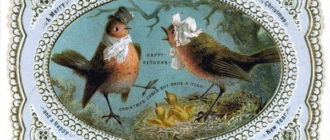Painting Bacchante Singing Cupid by Fyodor Bruni is a gentle image from ancient Greek mythology
Bacchante Singing Cupid is a painting by Fyodor Antonovich Bruni in 1828. In the center of the composition, in a semi-nude form, a charming companion of the ancient Greek god Dionysus is depicted. Her dark hair is adorned with green vine leaves, her sensual lips are slightly parted. Pressing the baby to her chest, the heroine brings a golden jug to his lips.
Cupid peers with interest deep into the vessel. His body, with plump arms and rosy cheeks, is filled with life, golden curls fall on his forehead. The dazzling white skin of the characters stands out against the dark background with a branch of a small-leaved plant on the right. The contrast is created by the red cloth tied at the hips of the Bacchae. The audience is captivated by the calm, soft look of the main character, filled with tenderness and love.

Name of the painting: “Bacchante Singing Cupid”.
Author: Fyodor Antonovich Bruni (1799-1875).
Year of writing: 1828
Size: 91 x 67 cm.
Style: Academicism.
Genre: Mythological scene.
Technique: Oil painting.
Material: Canvas.
Location: State Russian Museum, St. Petersburg.
Fedor Bruni – Russian painter of Italian origin
Fyodor Brunia is a bright representative of academic traditions in the art of the 19th century, a magnificent master of historical, religious and genre scenes. Being a hereditary artist with a good education, he masterfully owned a brush. His works were highly valued among Russian and European connoisseurs of painting. Antique and biblical subjects became especially successful in the master’s work.
Bruni painted the painting “Bacchae Singing Cupid” in 1828 during a long stay in Italy, where he studied high art. The influence of Venetian painters is reflected in the composition, tonal nuances and light saturation of the work.
Using chiaroscuro and brightening the warm shades of colors, the master gave volume to the forms and achieved an airy effect. His characters seem to breathe happiness, filled with sensual bliss and health. The gap between the tree trunks in the background creates perspective and a sense of depth. In the guise of a Bacchante, Fyodor Antonovich embodied the features of the young Italian beauty Angelica Serni, with whom he was passionately in love.
Despite the sympathy of the girl, it was not possible to obtain the consent of her parents for marriage.
A poor artist from Russia was not a match for a girl from a rich and influential Roman family. But the young man did not back down and expressed his feelings in his work, creating at the same time a chaste and erotic image, full of passionate languor and the beauty of motherhood. And seven years later he achieved the approval of his parents.
In 1835, the master married his muse. The painting “Bacchante Singing Cupid” by Fyodor Bruni has become one of the best works in which the author managed to reflect the romantic dreaminess of youth. A year later, the artist was going to present the work at an exhibition in the Capitol, but was refused with a reference to the canons that did not allow the nudity of characters. In subsequent work, the master refrained from using such bold innovative ideas.






